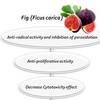Impacts of supplementing broiler diets with a powder mixture of black cumin, Moringa and chicory seeds
Author details:
The present study aimed at evaluating the effect of a phytogenic mixture in the diet on broiler production. A total of 400 day-old unsexed Cobb broiler chicks were randomly allotted to four treatment groups of 10 replications in a randomised design experiment. The phytogenic feed mixture (BMC) contained equal ratios of black cumin, Moringa oleifera and chicory seeds. The treatment groups were as follows: T1 was fed the basal diet, while T2, T3 and T4 were fed the basal diet supplemented with 0.2%, 0.4% or 0.6% of three BMC mixture, respectively. Results showed that increasing the dietary BMC level could be associated with a gradual but significant increase in body weight and improvement in the feed conversion ratio when compared with the control group. Broiler diets enriched with 0.4% to 0.6% of the BMC mixture reduced gut microbial count of coliforms, E. coli and C. perfringens as well as gut pH, compared to the control group. Increasing the dietary BMC mixture level was associated with gradual but significant decrease in serum total cholesterol, low density lipoprotein concentrations and liver enzymes concentrations. However, there was an increase in the high density lipoprotein concentration, and glutathione peroxidase and superoxide dismutase activity in serum. In conclusion, the BMC mixture could be deemed an effective growth promoter, but further research is needed to evaluate it as a viable alternative to antibiotics.
Keywords: blood, broiler, carcass, microbiota, oxidative status, performance, phytogenic.







Abd El-Hack, M.E. & Alagawany, M., 2015. Performance, egg quality, blood profile, immune function, and antioxidant enzyme activities in laying hens fed diets with thyme powder. J. Anim. Feed Sci. 24, 127-133.
Abd El-Hack, M.E., Alagawany, M., Farag, M.R., Tiwari, R., Karthik, K. & Dhama, K., 2016a. Nutritional, healthical and therapeutic efficacy of black cumin (Nigella sativa) in animals, poultry and humans. Int. J. Pharmacol. 12, 232-248.
Abd El-Hack, M.E., Alagawany, M., Saeed, M., Arif, M., Arain, M.A., Bhutto, Z.A. & Fazlani, S.A., 2016b. Effect of gradual substitution of soybean meal by Nigella sativa meal on growth performance, carcass traits and blood lipid profile of growing Japanese quail. J. Anim. Feed Sci. 25, 244-249.
Abd El-Hack, M.E., Alagawany, M., Ragab Farag, M., Tiwari, R., Karthik, K., Dhama, K., Zorriehzahra J. & Adel, M., 2016c. Beneficial impacts of thymol essential oil on health and production of animals, fish and poultry: a review. J. Essen. Oil Res. 28(5), 365-382.
Abd El-Hack, M.E., Attia, A.I., Arif, M., Soomro, R.N. & Arain, M.A., 2018. The impacts of dietary Nigella sativa meal and Avizyme on growth, nutrient digestibility and blood metabolites of meat-type quail. Anim. Prod. Sci. 58, 291-298, DOI:10.1071/AN16226.
Abd El-Mageed, M.N., 2011. Hepatoprotective effect of feeding celery leaves mixed with chicory leaves and barley grains to hypercholesterolemic rats. Mag. Pharm. 7, 151-156. DOI.org/10.4103/0973-1296.80675
Abdo, M. & Zeinb A., 2004. Efficacy of acetic acid in improving the utilization of low protein-low energy broiler diets. Egypt Poult. Sci. 24, 123-141.
Akiba, Y., Jensen, L.S., Bart, C.R. & Kraeling, R.R., 1982. Plasma estradiol, thyroid hormones and liver lipids determination in birds. J. Nutr. 112, 299-308.
Alabi, O.J., Malik, A.D., Ng’ambi, J.W., Obaje, P. & Ojo, B.K., 2017. Effect of Aqueous Moringa oleifera (Lam) Leaf Extracts on Growth Performance and Carcass Characteristics of Hubbard Broiler Chicken. Rev. Bras. Cienc. Avic. 19, 273-280.
Alagawany, M., Abd El-Hack, M.E., Arain, M.A. & Arif, M., 2017. Effect of some phytogenic additives as dietary supplements on performance, egg quality, serum biochemical parameters and oxidative status in laying hens. Indian J. Anim. Sci. 87, 103-110.
Alagawany, M. & Abd El-Hack, M.E., 2015. The effect of rosemary herb as a dietary supplement on performance, egg quality, serum biochemical parameters, and oxidative status in laying hens. J. Anim. Feed Sci. 24, 341-347.
Ali, A., 2011. Effect of different levels of Chicory cichoriumintybus L., Zizaphora zizaphoratenuior L., nettle Urticadioica L. and Savoury saturejahortensis L. medicinal plants on carcass characteristics of male broilers. J. Med. Plants Res. 5, 4354-4359.
Ali, O.A.A., Suthama, N. & Mahfudm, L.D., 2014. The effect of feeding black cumin Nigella Sativa. and vitamin c on blood lipid profiles and growth performance of broilers. Int. Ref. J. Engin. Sci. 3, 28-33.
Aruna M. & Srilatha N., 2012. Water clarification using Moringaoleifera Lam. seed as a natural coagulant. Current Biotica. 5, 472-486.
Attia, Y.A., & Al-Harth, M.A., 2015. Nigella sativa seed oil as an alternative to antibiotic growth promoters for broiler chickens. Eur. Poult. Sci. 79, 1-12, 2015.
Ayssiwede, S.B., Dieng, A., Chrysostome, C., Ossebi, W., Hornick, J.L. & Missohou, A., 2010. Digestibility and metabolic utilization and nutritional value of Leucaenaleucocephala Lam. leaves meal incorporated in the diets of indigenous Senegal chickens. Int. J. Poult. Sci. 9, 767-776. DOI.org/10.3923/ijps.2010.767.776
Basuny, A.M. & Al-Marzouq, M.A., 2016. Biochemical studies on Moringa oleifera seed oil. MOJ Food Process Technol. 2, 40-46.
Brantner, A., Pfeiffer, K.P. & Brantner, H., 1994. Applicability of diffusion methods required by the pharmacopoeias for testing antibacterial activity of natural compounds. Pharmazie. 49, 512-6.
Cabuk, M., Bozkurt, M., Alcicek, A., Akbas, Y. & Kucukyilmaz, K., 2006. Effect of a herbal essential oil mixture on growth and internal organ weight of broilers from young and old breeder flocks. S. Afr. J. Anim. Sci. 36, 135-141. DOI.org/10.4314/sajas.v36i2.3996
Cho, J.H., Kim, H.J. & Kim, I.H., 2014. Effects of phytogenic feed additive on growth performance, digestibility, blood metabolites, intestinal microbiota, meat color and relative organ weight after oral challenge with Clostridium perfringens in broilers. Livest. Sci. 160, 82-88. DOI.org/10.1016/j.livsci.2013.11.006
Ebru, U., Burak, U., Yusuf, S., Reyhan, B., Arif, K., Faruk, T.H., Emin, M., Aydin, K., Atilla, I.I., Semsettin, S. & Kemal, E., 2008. Cardioprotective effects of Nigella sativa oil on cyclosporine A-induced cardio toxicity in rats. Basic Clin. Pharmacol. Toxicol. 103, 574-580.
Fotina, A.A., Fisinin, V.I. & Surai, P.F., 2013. Recent developments in usage of natural antioxidants to improve chicken meat production and quality. Bulgarian J. Agric. Sci. 19, 889-896.
Gilani, A.H., Janbaz, K.H. & Shah, B.H., 1998. Esculetin prevents liver damage induced by paracetamol and CCl4. Pharmacol. Res. 37, 31-35.
Gilani, A.H., Jabeen, Q. & Khan, M.A.U., 2004. A review of medicinal uses and pharmacological activities of Nigella sativa. Pak. J. Biol. Sci. 7, 441-451.
Gopalakrishnan, L., Doriya, K. & Kumar, D.S., 2016. Moringa oleifera: A review on nutritive importance and its medicinal application. Food Sci. Human. Welln. 5, 49-56. DOI.org/10.1016/j.fshw.2016.04.001
Guler, T.B. & Ertas, O.N., 2006. The effect of dietary black cumin seeds Nigella Sativa L. on the performance of broilers. Asian-Austral. J. Anim. Sci. 19, 425-430. DOI.org/10.5713/ajas.2006.425
Gurnani, N., Gupta, M., Mehta, D. & Mehta, B.K., 2016. Chemical composition, total phenolic and flavonoid contents, and in vitro antimicrobial and antioxidant activities of crude extracts from red chilli seeds (Capsicum frutescens l.). J. Taibah Univ. Sci. 10, 462-470.
Hassan, H.A. & Yousef M.I., 2010. Ameliorating effect of chicory Cichoriumintybus L. supplemented diet against nitrosamine precursors-induced liver injury and oxidative stress in male rats. J. Food Chem. Toxicol. 48, 21-63. DOI.org/10.1016/j.fct.2010.05.023
Hassan, U.K., Khalique, A., Pasha, T.N., Akram, M., Mahmood, S., Sahota, A., Imran, M.S. & Saleem, G., 2017. Influence of Moringa oleifera decorticated seed meal on broiler performance and immunity. Pakistan Vet. J. 37, 47-50.
Ismail, Z.S.H., 2011. Effects of dietary black cumin growth seeds Nigella sativa L or its extract on performance and total coliform bacteria count on broiler chicks. Egypt Poult. Sci. 31, 139-149.
Khajuria, A., Thusu, N. & Zutshi, U., 2002. Piperine modulates permeability characteristics of intestine by inducing alterations in membrane dynamics: influence on brush border membrane fluidity, ultrastructure and enzyme kinetics. Phytomed. 9, 224-231. DOI.org/10.1078/0944-7113-00114
Lotosh, T.D., 1991. Experimental bases and prospects for the use of humic acid preparations from peat in medicine and agricultural production. Nauchnye Doki. Vyss. Shkoly. Biol.Nauki. 10, 99-103.
Marzouk, M., Sayed, A.A. & Soliman, A.M., 2011. Hepatoprotective and antioxidant effects of Cichorium endivia L. leaves extract against acetaminophen toxicity on rats. J. Med. Med. Sci. 2, 1273-1279.
Marzoni, M., Chiarini, R., Castillo, A., Romboli, I., De Marco, M. & Schiavone, A., 2014. Effects of dietary natural antioxidant supplementation on broiler chicken and Muscovy duck meat quality. Anim. Sci. Paper Rep. 32, 359-368.
Meda, A., Lamien, C.E., Romito, M., Millogo, J. & Nacoulma, O.G., 2005. Determination of the total phenolic, flavonoid and proline contents in burkina fasan honey, as well as their radical scavenging activity. Food Chem. 91, 571-577
Molepo, L.S., 2014. Effect of Moringa seed meal supplementation on productivity and carcass characteristics of ross 308 broiler chickens. PhD dissertation. University of Limpopo.
Noreen, S., 2009. Antihepatotoxic effects of Cichoriumintybus Kasni. seeds against liver damage induced by carbon tetrachloride and paracetmol in broiler chicks, MSc. Thesis. Dept. Vet.Clinical Medicine, Univ. Agri. Faisalabad, Pakistan.
NRC., 1994. Nutrient Requirements of Poultry. National Academy Press, Washington, DC. DOI.org/10.17226/2114
Perić, L., Žikić, D. & Lukić, M., 2009. Application of alternative growth promoters in broiler production. Biotech. Anim. Husb. 25, 387-397. DOI.org/10.2298/bah0906387p
Saeed, M., Abd El-Hack, M.E., Alagawany, M., Arain, M.A., Arif, M., Mirza, M.A., Naveed, M., Chao, S., Sarwar, M., Sayab, M. & Dhama, K., 2017. Chicory Cichorium intybus. Herb: chemical composition, pharmacology, nutritional and healthical applications. Int. J. Pharmacol. 13, 351-360. DOI.org/10.3923/ijp.2017.351.360
Safamehr, A., Fallah, F. & Nobakht, A., 2013. Growth performance and biochemical parameters of broiler chickens on diets consist of chicory Cichoriumintybus. and nettle Urticadioica. with or without Multi‐Enzyme. Iranian J. Appl. Anim. Sci. 3, 131-137.
SAS Institute Inc., 2001. SAS User’s Guide.Release 8.2. SAS Institute Inc, Cary, NC.
Thompson, L.U., 1993. Potential health benefits and problems associated with anti-nutrients with foods. Food Res. Int. 26,131-49. DOI.org/10.1016/0963-996993.90069-u
Wenk, C., 2003. Herbs and botanicals as feed additives in monogastric animals. Asian-Austral. J. Anim. Sci. 16, 282-289.
















